
Taming the Thorny Beast: A Novice's Guide to Raspberry Bushes
Published: 08/04/2024 | Updated: 21/05/2024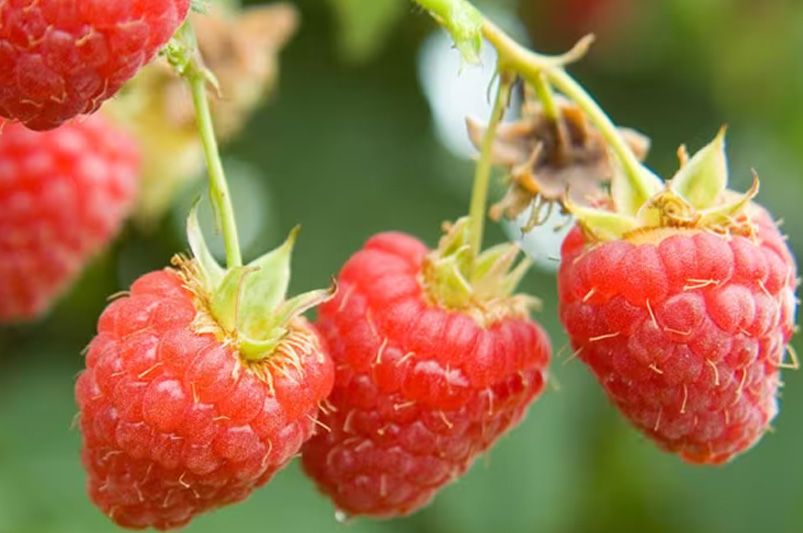
Raspberries are a popular and delicious fruit that can be grown easily in home gardens. They are members of the rose family and come in a range of colors including red, black, purple, yellow, red raspberry, and golden. Their sweet and slightly tart flavor makes them ideal for eating fresh, baking, jams, desserts, and more.


In this article, we will provide key information on choosing varieties, ideal growing conditions, proper planting techniques, care and maintenance, harvesting, and troubleshooting common problems. Whether you're new to gardening or an experienced grower, cultivating raspberry bushes can be an enjoyable and fruitful endeavor. Let's explore the basics of transforming your raspberry bush plants from thorny nuisances to sweet, juicy treasures.
Benefits of Growing Raspberries
Raspberries provide many benefits that make them a worthwhile fruit to grow at home. Here are some of the top reasons to try your hand at raspberry cultivation:
Health Benefits
They are packed with antioxidants, vitamins, and minerals that make them a nutritious addition to your diet. They are high in vitamin C, manganese, and fiber. The ellagic acid and anthocyanins found in raspberries have anti-inflammatory and anti-cancer properties. Eating raspberries regularly can help reduce your risk of various chronic diseases.
Cost Savings
When you grow your raspberries, you can reap substantial savings on other raspberries versus purchasing them at the grocery store, especially for organic varieties. Raspberry plants are perennials that provide fruit for 10-20 years when cared for properly. A small raspberry patch with just a few plants can provide pounds of fresh berries for your family every summer.
Fun Family Activity
Caring for raspberry plants and picking fresh raspberries can be a fun outdoor activity the whole family will enjoy. Kids love hunting for ripe, juicy berries among the leaves. Raspberry picking provides a great opportunity to teach children about gardening, nature, and the benefits of eating fresh produce. The hands-on experience of tending the plants and plucking their flavorful, sweet berries often gets kids excited about eating more fruits and veggies.
Growing your raspberries provides delicious, nutritious fruit while saving money and creating family memories during the growing season. With proper care, raspberries are not difficult to cultivate even for beginners.
Choosing a Raspberry Variety
Raspberries come in a range of varieties, each with its unique characteristics. When selecting which types to grow, consider factors like harvest season, growth habits, hardiness, and flavor profiles.
Popular Varieties
Some top raspberry cultivars include:
-
Canby Raspberry: Canby Raspberry (Rubus idaeus 'Canby Red') is a popular red raspberry cultivar known for its large, juicy berries with a sweet flavor and a hint of tartness. It is a hardy, disease-resistant variety that produces high yields of fruit in late June to early July. Canby Raspberries are perfect for fresh eating, jams, jellies, and baking, making them a favorite among gardeners and berry lovers alike.
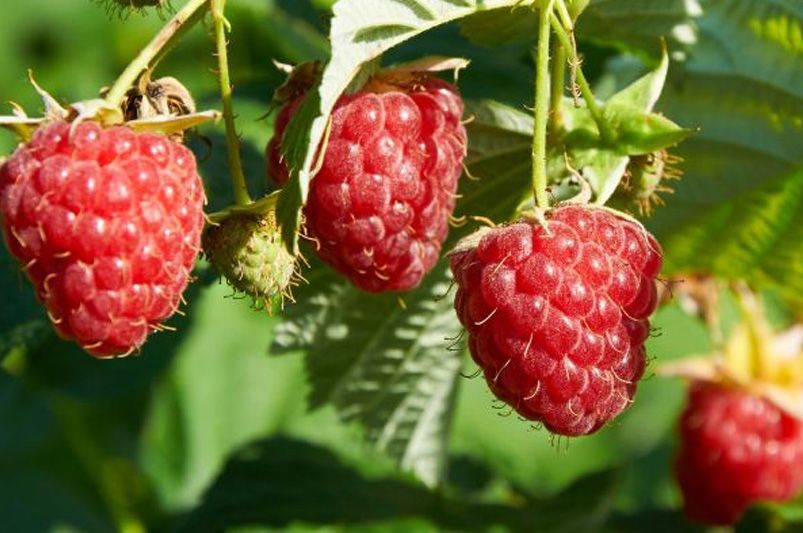
-
Caroline Raspberry: Caroline Raspberry (Rubus idaeus 'Caroline') is a popular cultivar known for its large, flavorful fruits that ripen in early summer. This variety is also known for its disease resistance and high yield, making it a favorite among home gardeners and commercial growers alike. The plants themselves are thornless and upright, making them easy to harvest and maintain. Overall, the Caroline Raspberry is a great choice for anyone looking to grow a reliable and delicious raspberry variety.
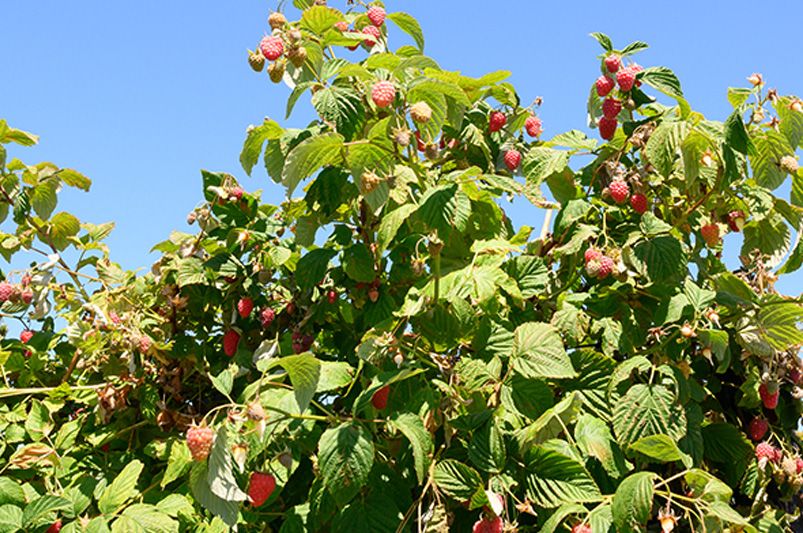
-
Encore Raspberry: Encore Raspberry is a popular variety of raspberry bush that produces large, firm, and sweet fruit. It is known for its ability to bear fruit twice a year, once in late spring or early summer and again in early fall. This makes it an ideal plant for those who want to enjoy fresh raspberries for a longer period of time. Encore Raspberry is also easy to grow and maintain, making it a great choice for beginners and experienced gardeners alike.
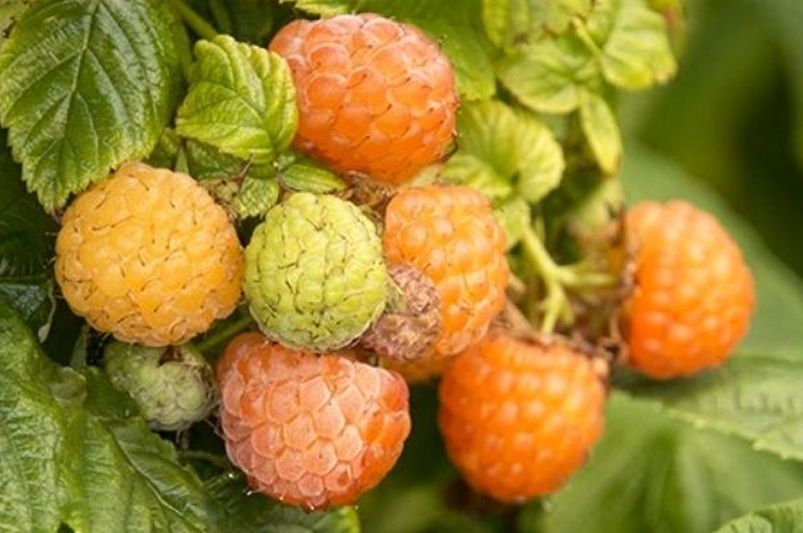
-
Fall Gold Raspberry: The Fall Gold Raspberry (Rubus idaeus var. strigosus 'Fall Gold') is a unique variety of raspberry that is highly sought after for its delicious flavor and golden color. This deciduous fruiting plant produces large, sweet berries in late summer and early fall. It is known for its vigorous growth and disease resistance, making it a popular choice for home gardeners and commercial growers alike.
Summer vs. Fall Croppers
When selecting raspberry varieties, one key choice is between summer and fall croppers:
-
Summer croppers: Produce one crop of berries in mid-summer on two-year-old canes. Varieties include Tulameen and Anne.
-
Fall croppers: Yield a crop in late summer on first-year canes, and again in fall on those same floricanes. Caroline and Heritage are examples.
-
Everbearing: Bear fruit continuously on first-year canes from summer until fall frost. Heritage is a popular everbearing type.
Flavor Profiles
Raspberry varieties differ in their flavor profiles:
-
Red: Range from robust, rich, raspberry flavor (Heritage) to milder, more delicate tastes (Tulameen).
-
Yellow: Tend to be extremely sweet and mild. Great for eating fresh.
-
Black/Purple: More aromatic flavors, often described as musky or wine-like. Firm, juicy texture.
-
Gold: Mild, sweet, honey-like flavor. Less tart than yellow berries or red varieties.
Consider your flavor preferences when selecting among the many raspberry cultivars. Taste-testing different types can help identify your favorites.
Don't miss out on the joy of growing your raspberries! Visit ShrubHub today to explore our wide selection of raspberry varieties and make an informed choice for your garden. Start your raspberry-growing journey with confidence, knowing that you have the support and expertise of ShrubHub behind you.
Click here to visit ShrubHub and choose your perfect raspberry variety: ShrubHub
Ideal Growing Conditions
Raspberry bushes thrive in specific growing conditions that enhance their fruit production and overall health. Here are the ideal conditions for growing raspberry bushes:
Sunlight: Raspberry bushes need plenty of sunlight to flourish. Ideally, they should be planted in full sun or in a location that receives full sun for at least six to eight hours a day.
Soil: Well-draining, fertile soil is essential for raspberry bushes. The soil should be rich in organic matter and have a slightly acidic pH level between 5.5 and 6.5. Adding compost or well-rotted manure can improve soil quality.
Water: Raspberry bushes require consistent moisture, especially during the growing season and fruit production. It's best to water the plants at the base to avoid wetting the foliage, which can lead to disease. A drip irrigation system can be beneficial for ensuring consistent moisture.
Spacing: Proper spacing is crucial for healthy raspberry bushes. Plant bushes about 2-3 feet apart in rows, with 8-10 feet between rows. This allows for good air circulation and facilitates harvesting.
Temperature: Raspberry bushes thrive in temperate climates. They are generally hardy in USDA zones 4-8, but specific varieties may be better suited to particular regions. Adequate air circulation helps prevent disease, and a layer of mulch can help regulate soil temperature.
Pruning: Regular pruning is essential for maintaining the health and productivity of raspberry bushes. Prune out old canes after fruiting and thin out new canes with annual pruning to encourage strong growth.
By providing these ideal growing conditions, you can ensure that your raspberry bushes produce abundant, flavorful fruit for many years to come.
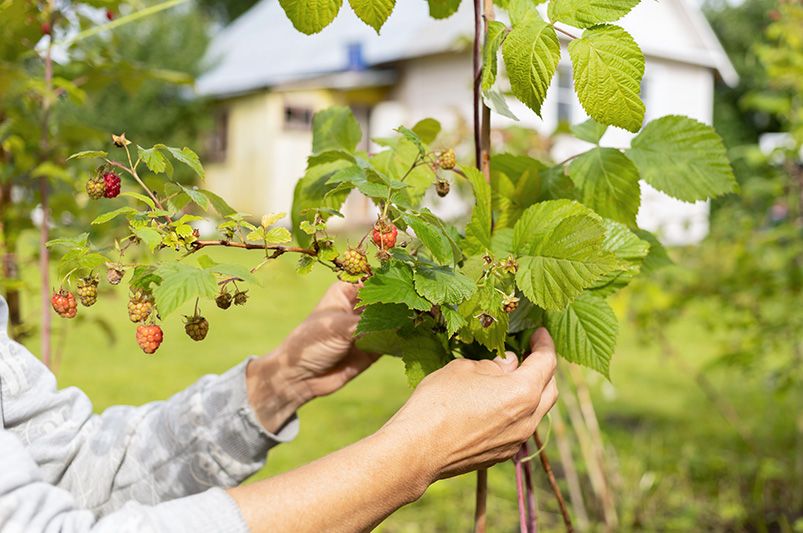
Preparing the Planting Site
Proper site preparation is key to getting your raspberry bushes off to a good start. Here are some tips for preparing your planting area:
Bed Preparation
Raspberries grow best in raised garden beds that are at least 12-18 inches high. The raised beds improve drainage and allow you to amend the soil more easily. Locate your raspberry bed in full sun (at least 6 hours per day) with good air circulation. Raspberries prefer slightly acidic soil with a pH between 5.5 and 6.5.
Remove any existing sod or weeds from your raspberry planting area. Till the native soil about 8-12 inches deep to break up any compaction. Add 2-3 inches of compost and mix thoroughly into the soil to enrich it. Raspberries thrive well well-drained soil and in loamy, well-draining soil.
Soil Amendment
In addition to compost, mix in 1 cup of bone meal per 10 square feet of planting area. This provides a boost of phosphorus to help your raspberry plants become established. You can also add worm castings or well-rotted manure.
Just before planting, do a soil test to determine if any other amendments are needed. Raspberries benefit from potassium for good cane growth. Adding sulfur may help lower the soil pH if needed.
Irrigation
Install drip irrigation or soaker hoses in your raspberry beds before planting. Raspberries need consistent moisture, about 1-2 inches per week. Drip irrigation targets the water right to the raspberry plant and roots and helps prevent foliar diseases.
Make sure your irrigation system is operational before planting day. Proper site preparation and irrigation will set your raspberry planting up for success.
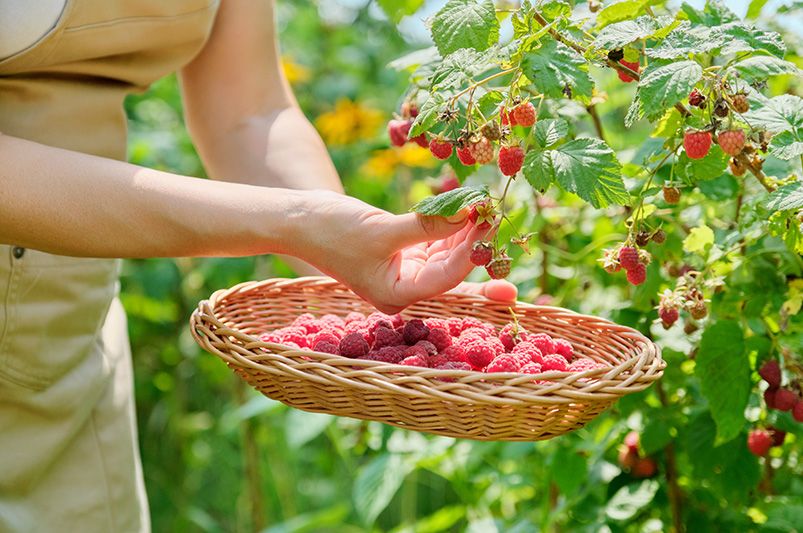
Plant Raspberries
Raspberries can be planted in spring, summer, fall crop, or only a fall crop, depending on your preference and local climate. There are two main ways to get started:
Transplants vs Seeds
Transplants are the easiest and quickest way to grow. Look for healthy, green, 1-2-year-old plants from your local nursery. Transplants will establish more quickly and will produce fruit and berries sooner than seeds.
Starting from seeds takes patience and extra care. Sow seeds indoors 8-10 weeks before your last frost date. Plant the seedlings outside after the danger of frost has passed. Keep the soil moist and provide partial shade as the seeds germinate over 2-4 weeks. Thin seedlings to the strongest plant every 6 inches.
Planting Schedule
Spring planting is ideal in cooler climates. Wait until two crops after the last frost when soil temperatures reach at least 55°F. Plant in early spring for berries that summer.
Fall planting works well for warmer regions. Plant 1-2 months before the first frost so plants establish roots before winter dormancy. Mulch in well-drained soil to protect from cold. Expect berries the following summer only two summers after planting.
Spacing
Keep raspberry plants 2-3 feet apart in rows, and with 6-8 feet between rows. Raspberries spread via underground rhizomes, so leave enough room for the plants to expand over time. Dig holes large enough to accommodate the root system without bunching.
Care and Maintenance
Taking proper care of your raspberry bushes is key to ensuring their health and productivity. Here are essential care and maintenance tips for raspberry bushes:
Watering
Raspberry bushes need consistent moisture, especially during the growing season and fruit production. Water the raspberry plants deeply at least once a week, providing about 1 inch of water. Avoid over-watering, as it can result in root rot. Mulching around the plants can help retain moisture in the soil.
Fertilizing
Raspberry bushes benefit from regular fertilization to promote healthy growth and fruit production. Apply a balanced fertilizer in early spring before new growth begins. Follow the package instructions for the appropriate amount to use. Avoid over-fertilizing, as it can lead to excessive vegetative growth.
Pruning
Pruning is essential for maintaining the health and productivity of raspberry bushes. Prune out old, spent raspberry canes (those that have fruited) in late summer or early fall. Thin out new canes, leaving no more than 6-8 per linear foot, to encourage strong growth. Cutting back the tips of the canes can help control their height and promote branching.
Winter Protection
Raspberry bushes are generally hardy, but cold winter temperatures can damage them. Before winter, mulch around the base of the plants with straw or leaves to protect the roots from freezing temperatures.
By following these care and maintenance tips, your raspberry bushes produce fruit and will remain healthy and productive, providing you with delicious fruit year after year.
Harvesting
Raspberries are one of the most delicious fruits to harvest fresh from your garden. Knowing when and how to properly harvest them will ensure you enjoy their full flavor and yield.
When to Harvest
Summer-bearing red and yellow raspberries: Harvest when the berries are fully ripe, usually starting in mid-summer. Ripe purple and red raspberries that will easily come off the receptacle (white core) when gently pulled.
Fall-bearing yellow raspberries: Begin harvesting when the berries start to develop full color, usually in early spring through late summer into fall.
Everbearing red raspberries: Can be harvested from early summer through fall. Pick berries when they are fully ripe.
Avoid harvesting berries that are dull, mushy, or moldy. The ideal time for firm berries is when they have developed their full color but still feel firm.
How to Harvest
-
Gently pluck ripe berries individually, leaving the receptacle on the plant. Avoid yanking clusters which can damage the plant.
-
Use a shallow container to collect berries as you pick. This prevents crushing.
-
Pick berries frequently, every 2-3 days. This encourages continued production.
-
Avoid picking when berries are wet, as they are very delicate.
-
For a second fall crop, cut everbearing and fall-bearing plants back substantially after the summer harvest.
Storage
Raspberries are highly perishable. Enjoy them as soon as possible for the best flavor and quality.
-
Refrigerate unwashed berries promptly in a shallow container. Do not wash until ready to eat, as moisture speeds up spoilage.
-
Berries will usually last 1-2 weeks in the refrigerator.
-
To freeze, arrange berries in a single layer on a cookie sheet and place in the freezer until solid. Transfer to freezer bags.
-
For longer storage, raspberries also can be canned or preserved in jams and other products. Follow proper canning procedures for food safety.
Proper harvesting and gentle handling keep raspberries fresh and flavorful to enjoy. With some basic tips, you'll be ready to reap the rewards of your fresh raspberry harvest.
Pest and Disease
Raspberries can face a variety of issues that affect their health and productivity. Being aware of potential problems can help you identify and address them early. Some of the most common raspberry problems include:
Diseases
Anthracnose: Caused by a fungus, this disease creates purple or black spots on canes, leaves, and fruit. It thrives in warm, wet weather. Prune out affected canes and remove fallen leaves to prevent spread.
Cane Blight: This fungus causes cane tips to wilt and turn gray. It spreads in wet conditions. Prune out infected canes at least 6 inches below the affected area.
Verticillium Wilt: Fungal disease that causes leaves to yellow, canes to wilt, and reduced yields. Avoid planting in soil contaminated with verticillium.
Mosaic Virus: Causes light green, yellow, or white patterns on leaves and stunted plants. Spread by aphids. Remove and destroy affected plants.
Pests
Raspberry Beetle: Small white grub that tunnels into fruit, causing damage. Monitor for damaged fruit and pick promptly. Remove old fruit and canes.
Raspberry Crown Borer: Larvae bore into crowns and canes, weakening and killing the plant. Mound soil or mulch around crowns and dead canes to protect.
Spider Mites: Tiny pests that suck sap, causing stippling on leaves. Knock off with a hose or spray insecticidal soap.
Aphids: Suck plant sap and spread viruses. Monitor new growth and spray off with water. Attract beneficial insects.
Your Guide to a Thriving Raspberry Bushes
Remember, caring for raspberry bushes is a journey, not a destination. As your raspberry patch grows and thrives, you'll continue to learn and refine your techniques. But with the knowledge you've gained here, you're well on your way to cultivating a delicious and rewarding addition to your garden.
Are you ready to start growing delicious raspberries in your backyard? Look no further than ShrubHub, your go-to resource for choosing the perfect raspberry variety! With a wide selection of raspberry plants and expert guidance, ShrubHub makes it easy to find the right variety for your specific needs. Invest in your raspberry garden with ShrubHub, and enjoy the satisfaction of harvesting and savoring your very own homegrown raspberries.


